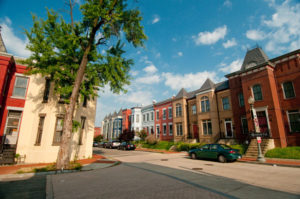Back

Blog
Howard University’s Strategic Anchor Engagement Continues to Benefit D.C.’s LeDroit Park Neighborhood

Originally founded as a segregated community in the late 19th century, LeDroit Park was the sight of demonstrations by Howard University students protesting the discriminatory policies of the neighborhood. Gradually, LeDroit Park became more racially and economically integrated, and by the beginning of the 20th century it was a thriving residential community, home to many prominent African-American residents, including Robert A. Terrell, the first African-American municipal judge, and his wife Mary Church Terrell, an educator and civil rights activist.
During the 1950s and 1960s, LeDroit Park experienced severe economic decline, with the university’s relationship with the neighborhood deteriorating as well. In the 1970s, Howard University began to purchase entire blocks in LeDroit Park with the objective of expanding Howard University Hospital. The expansion did not materialize and many of the properties purchased by the university stayed vacant for years, adding to existing neighborhood blight.
During this time, residents began to engage the university in conversations about the future of LeDroit Park, voicing concerns over the community’s deterioration and fears over the university’s inattention to the neighborhood.
In the 1990s, Howard University’s leadership began to address these issues directly. The university began by engaging its own officials, business leaders and community stakeholders in a broader conversation about how to revitalize the neighborhood. In 1995, the university’s newly hired president, H. Patrick Swygert, established the Howard University Community Association, aimed at strengthening the university’s relationship with its neighbors, as well as opening a dialogue on community projects and partnership opportunities. During this time, Howard University committed to redeveloping its vacant properties—45 in total—by pursuing a partnership with the Federal National Mortgage Association, commonly known as Fannie Mae.
Through a nearly two-year planning process, the partners ultimately agreed that the first priority would be to redevelop university-owned homes and vacant lots. In 1997, to help catalyze the “LeDroit Park Initiative,” the Fannie Mae Foundation allocated $1 million for a series of planning, economic development and land use studies aimed to inform the broader revitalization effort. The university secured another $2.4 million in grants from the U.S. Department of Housing and Urban Development to begin renovating several residential properties.
By purchasing special mortgage revenue bonds issued by the District of Columbia Housing Finance Agency, Fannie Mae offered below-market rate mortgages. Howard University also created a down payment assistance program to make homeownership accessible to residents from a range of economic backgrounds. The subsidies meant that university employees, policemen, firefighters and public school teachers could purchase one of the newly renovated homes with as little as three percent down. As a result, the first new residents ranged from physicians to members of the university’s janitorial staff.
The university also purchased and redeveloped a neighborhood liquor store into an office for both campus security and the D.C. Metropolitan Police Department, converted the previously fenced-off McMillan Reservoir area into a park, and renovated the Howard University Hospital, adding a trauma center and emergency room.
Phase II of the LeDroit Park Initiative, which was carried out in the early 2000s, included $25 million in public infrastructure improvements, such as alley repaving, improved lighting and better signage. Restoring the historic Howard Theatre, and adapting the area into a mixed-use cultural district, were also key parts of this second phase of private investment.
The work continues. Howard University recently released an RFQ in search of proposals to develop a two acre parcel adjacent to the main university campus. The project is intended to be a mixed-use development, including a ground floor destination, such as a food hall or market, to attract additional visitors. Howard has also recently partnered with two nonprofit community development corporations, Urban Investment Partners and Neighborhood Development Corporation, to convert two former dormitories into 162 units of mixed-income rental housing, with construction to begin in early 2018.
The LeDroit Park Initiative is great example of how a university can play an active and deliberate role in inner city revitalization. Howard University’s investment was the catalyst needed to attract follow-on private sector investment, and LeDroit Park is now part of the broader city’s economic resurgence. This influx of economic activity benefits the university too – bringing strong businesses back to the community, increased neighborhood amenities, improving public infrastructure and helping attract new students and employees to the university.
